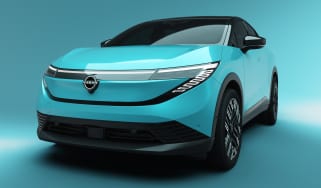Subaru Impreza hatchback (2007-2012)
“The Subaru Impreza WRX was great to drive, while entry-level versions were durable, well priced and generously equipped.”
Pros
- Strong reliability record
- Four-wheel drive gave plenty of grip
- Good levels of standard equipment
Cons
- Cheap cabin materials
- WRX models were expensive to run
- Resale values weren't great
The previous-generation Subaru Impreza was more comfortable and mature than the model it replaced. It offered buyers good value and was a well built and reliable car. The Impreza provided plenty of reassuring grip thanks to Subaru’s standard four-wheel-drive system – although this did make it expensive to run.
Inside, the Impreza was well built and robust, even if the design and materials used weren’t up there with rivals’ efforts. Diesel Imprezas were expensive to buy, but offered reasonable economy. The high-performance WRX model exploited the grip on offer with a larger and more powerful engine and this version still holds appeal for keen drivers after a fast and agile hatchback.
MPG, running costs & CO2
This was the first model of Impreza available with a diesel engine and while it cost more than the petrol, it did manage a reasonable 47.9mpg. CO2 emissions were a less than competitive 152g/km, though, meaning a diesel Impreza will cost you £180 a year in road tax today.
There were three petrol engines available: the entry-level 1.5-litre returned a not hugely impressive 37.7mpg and emitted 176g/km of CO2, making road tax £225 a year at present. The 2.0-litre petrol managed comparable economy: 33.6mpg and CO2 emissions of 199g/km, for a tax bill of £265 today.
More reviews
High-performance Subaru Imprezas have never been about economy and this remained true for the 2007-2012 Impreza. The Impreza WRX returned just 27.2mpg and will cost you £490 a year to tax, thanks to its 246g/km CO2. The seriously rapid Impreza WRX STI 330S only managed 23.7mpg and was liable for the top rate of road tax (which presently stands at £505) as a result of the 281g/km CO2 it produced.
Entry-level Imprezas were reasonably cheap to insure, being in insurance groups 11-25. Getting cover for the fast and powerful Impreza WRX was never going to be affordable, though: these performance models were in groups 36-40.
Engines, drive & performance
The 106bhp 1.5-litre and 148bhp 2.0-litre petrol engines felt underpowered in the Impreza and are best avoided. The 2.0-litre diesel was very smooth and propelled the Impreza well. It had the same 148bhp output as the petrol, but delivered its power in a much more useable manner.
High-performance Imprezas have always been great cars to drive and this remained true with this generation of the WRX, both version of which offered accurate gearchanges and precise steering.
The Impreza WRX’s 2.5-litre petrol engine produced 227bhp and, when combined with Subaru’s four-wheel-drive system, meant the WRX could make seriously rapid progress, particularly on cross-country ‘A’ roads. The WRX STI 330S gave drivers near-supercar performance and its 325bhp engine isn’t for the faint-hearted.
Interior & comfort
Standard Imprezas were comfortable cars to drive thanks to their pliant suspension. This comfort did at times translate into too much body lean when cornering, though. The diesel engine was very quiet and suited the Impreza well, but the 1.5 and 2.0-litre petrols needed to be revved, making for a slightly unrefined driving experience.
The WRX models could be pretty loud, but this was in keeping with their nature and some drivers liked this, as it suited the car’s larger-than-life character well.
Inside, the Impreza’s cabin was a quiet place to sit, with very little road noise – although the large wing-mirrors did cause some wind whistle. The quality of the cabin materials wasn’t great, with cheap-feeling plastics in abundance. It all felt very well put together, though.
Practicality & boot space
The Impreza’s 301 litres of boot space was some way off the class leaders, although with the rear seats folded, this increased to an impressive 1,216 litres. Rear passengers had plenty of headroom and legroom, but anyone sitting in the middle back seat would have struggled for somewhere to put their feet. Although the cabin was well made, it wasn’t that well thought-out: Subaru provided door pockets in the front, but other than that it wasn’t hugely practical.
Reliability & safety
The Impreza’s four-star Euro NCAP safety rating was good, but drivers increasingly expect a car to score the full five stars. Subaru fitted anti-lock brakes and ISOFIX child-seat fixings as standard to all Imprezas.
The 1.5-litre petrol Impreza missed out on the electronic stability control fitted to all other models, although standard four-wheel-drive meant all cars offered excellent grip and were reassuring to drive in slippery conditions.
The Impreza had an uninspiring-looking cabin and materials felt cheap to the touch, but it did seem long-lasting and well built. Although this third-generation car came 133rd out of 200 models looked at in our 2015 Driver Power customer satisfaction survey, Subaru finished a respectable 12th out of 32 brands overall. Subaru owners praise its cars’ reliability and practicality, although running costs are reported to be high.
Price, value for money & options
The amount of standard equipment fitted to all Imprezas was generous. Subaru included a Bluetooth phone connection, electric windows, foglights and a CD player as standard. This made the Impreza a well equipped car for the price.
The diesel engine was a better prospect than the slightly uninspiring petrols, but it was expensive to buy, while the high-performance Imprezas offered impressive horsepower and acceleration, but the were expensive to run.
Subaru Imprezas didn’t hold their value well, although this makes them a more appealing car on the secondhand market, particularly for drivers after affordable performance.











